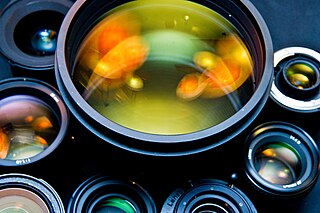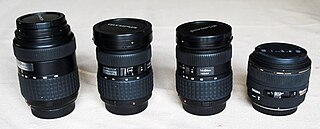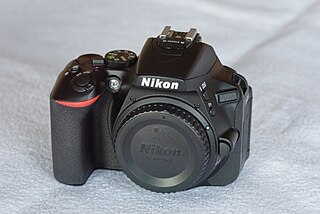A dandelion chip is an electronic device, installed on the bayonet mount of a non-electronic camera lens or adapter, which enables electronic interoperation with certain cameras. The device consists of an integrated circuit connected to a series of exposed electrical contacts, in a curved package which matches the lens mount. It is designed to be affixed in a particular position on the mount, in order to mate with matching contacts on the camera body. The contacts on both sides of the mount are commonly known as CPU contacts.

A bayonet mount or bayonet connector is a fastening mechanism consisting of a cylindrical male side with one or more radial pins, and a female receptor with matching L-shaped slot(s) and with spring(s) to keep the two parts locked together. The slots are shaped like a capital letter L with serif ; the pin slides into the vertical arm of the L, rotates across the horizontal arm, then is pushed slightly upwards into the short vertical "serif" by the spring; the connector is no longer free to rotate unless pushed down against the spring until the pin is out of the "serif".

A camera lens is an optical lens or assembly of lenses used in conjunction with a camera body and mechanism to make images of objects either on photographic film or on other media capable of storing an image chemically or electronically.

An integrated circuit or monolithic integrated circuit is a set of electronic circuits on one small flat piece of semiconductor material that is normally silicon. The integration of large numbers of tiny transistors into a small chip results in circuits that are orders of magnitude smaller, cheaper, and faster than those constructed of discrete electronic components. The IC's mass production capability, reliability and building-block approach to circuit design has ensured the rapid adoption of standardized ICs in place of designs using discrete transistors. ICs are now used in virtually all electronic equipment and have revolutionized the world of electronics. Computers, mobile phones, and other digital home appliances are now inextricable parts of the structure of modern societies, made possible by the small size and low cost of ICs.
Camera functions enabled by the chip may include exposure metering, aperture display and control, focus confirmation and fine-tuning, and Exif metadata recording.

In optics, an aperture is a hole or an opening through which light travels. More specifically, the aperture and focal length of an optical system determine the cone angle of a bundle of rays that come to a focus in the image plane.

In geometrical optics, a focus, also called an image point, is the point where light rays originating from a point on the object converge. Although the focus is conceptually a point, physically the focus has a spatial extent, called the blur circle. This non-ideal focusing may be caused by aberrations of the imaging optics. In the absence of significant aberrations, the smallest possible blur circle is the Airy disc, which is caused by diffraction from the optical system's aperture. Aberrations tend to get worse as the aperture diameter increases, while the Airy circle is smallest for large apertures.
Exchangeable image file format is a standard that specifies the formats for images, sound, and ancillary tags used by digital cameras, scanners and other systems handling image and sound files recorded by digital cameras. The specification uses the following existing file formats with the addition of specific metadata tags: JPEG discrete cosine transform (DCT) for compressed image files, TIFF Rev. 6.0 for uncompressed image files, and RIFF WAV for audio files. It is not used in JPEG 2000 or GIF.
The level of additional functionality enabled by the chip depends on the camera. Some cameras provide certain electronic functions even with a non-electronic lens. For example, professional-level Nikon DSLRs provide metering and focus confirmation, and store lens data programmed into the camera, regardless of whether the mounted lens has electronic contacts. By contrast, many consumer-level Nikon DSLRs require an electronically enabled lens to perform functions as basic as metering.

A single-lens reflex camera (SLR) is a camera that typically uses a mirror and prism system that permits the photographer to view through the lens and see exactly what will be captured. With twin lens reflex and rangefinder cameras, the viewed image could be significantly different from the final image. When the shutter button is pressed on most SLRs, the mirror flips out of the light path, allowing light to pass through to the light receptor and the image to be captured.

A digital camera or digicam is a camera that captures photographs in digital memory. Most cameras produced today are digital, and while there are still dedicated digital cameras, many more are now incorporated into devices ranging from mobile devices to vehicles. However, high-end, high-definition dedicated cameras are still commonly used by professionals.

Minolta Co., Ltd. was a Japanese manufacturer of cameras, camera accessories, photocopiers, fax machines, and laser printers. Minolta was founded in Osaka, Japan, in 1928 as Nichi-Doku Shashinki Shōten . It is perhaps best known for making the first integrated autofocus 35mm SLR camera system. In 1931, the company adopted its current name, an acronym for "Mechanism, Instruments, Optics, and Lenses by Tashima". In 1933, the brand name first appeared on a camera, a copy of the Plaubel Makina simply called "Minolta".

An autofocus optical system uses a sensor, a control system and a motor to focus on an automatically or manually selected point or area. An electronic rangefinder has a display instead of the motor; the adjustment of the optical system has to be done manually until indication. Autofocus methods are distinguished by their type as being either active, passive or hybrid variants.

A digital single-lens reflex camera is a digital camera that combines the optics and the mechanisms of a single-lens reflex camera with a digital imaging sensor, as opposed to photographic film. The reflex design scheme is the primary difference between a DSLR and other digital cameras. In the reflex design, light travels through the lens, then to a mirror that alternates to send the image to either the viewfinder or the image sensor. The traditional alternative would be to have a viewfinder with its own lens, hence the term "single lens" for this design. By using only one lens, the viewfinder of a DSLR presents an image that will not differ substantially from what is captured by the camera's sensor. A DSLR differs from non-reflex single-lens digital cameras in that the viewfinder presents a direct optical view through the lens, rather than being captured by the camera's image sensor and displayed by a digital screen.

The Nikon F-mount is a type of interchangeable lens mount developed by Nikon for its 35mm format single-lens reflex cameras. The F-mount was first introduced on the Nikon F camera in 1959, and features a three-lug bayonet mount with a 44 mm throat and a flange to focal plane distance of 46.5 mm. The company continues to use variations of the same lens mount specification for its film and digital SLR cameras.

The M42 lens mount is a screw thread mounting standard for attaching lenses to 35 mm cameras, primarily single-lens reflex models. It is more accurately known as the M42 × 1 mm standard, which means that it is a metric screw thread of 42 mm diameter and 1 mm thread pitch. It was first used in Zeiss' Contax S of 1949; this East German branch of Zeiss also sold cameras under the Pentacon name; after merger with other East German photographic manufacturers, the name Praktica was used. M42 thread mount cameras first became well known under the Praktica brand, and thus the M42 mount is known as the Praktica thread mount. Since there were no proprietary elements to the M42 mount, many other manufacturers used it; this has led to it being called the Universal thread mount or Universal screw mount by many. The M42 mount was popularized in the United States by Pentax; thus, it is also known as the Pentax thread mount, despite the fact that Pentax did not originate it.
The T-mount is a standard lens mount for cameras and other optical assemblies. The usual T-mount is a screw mount using a male 42×0.75 metric thread on the lens with a flange focal distance of 55 mm and a mating female 42mm thread on a camera adapter or other optical component. This thread form is referred to as T-thread.

Live preview is a feature that allows a digital camera's display screen to be used as a viewfinder. This provides a means of previewing framing and other exposure before taking the photograph. In most such cameras, the preview is generated by means of continuously and directly projecting the image formed by the lens onto the main image sensor. This in turn feeds the electronic screen with the live preview image. The electronic screen can be either a liquid crystal display (LCD) or an electronic viewfinder (EVF).

This article is about photographic lenses for single-lens reflex film cameras (SLRs) and digital single-lens reflex cameras (DSLRs). Emphasis is on modern lenses for 35 mm film SLRs and for DSLRs with sensor sizes less than or equal to 35 mm ("full-frame").

The Nikon D60 is a 10.2-megapixel Nikon F-mount digital single-lens reflex camera announced in January 2008. The D60 succeeds the entry-level Nikon D40x. It features the Nikon EXPEED image processor introduced in the higher-end Nikon D3 and D300.

The Nikon D90 is a 12.3 megapixel digital single-lens reflex camera (DSLR) model announced by Nikon on August 27, 2008. It is a prosumer model that replaces the Nikon D80, fitting between the company's entry-level and professional DSLR models. It has a Nikon DX format crop sensor.

The Nikon D3000 is a 10.2-megapixel DX format DSLR Nikon F-mount camera announced by Nikon on 30 July 2009. It replaces the D40 as Nikon's entry level DSLR. It features a 3.0-inch 230,000-dot resolution LCD monitor, CCD sensor with ISO 100–1600 and 3D tracking Multi-CAM1000 11-point AF system which makes it quite similar to the Nikon D200 in these main parts. Initially priced with $599 MSRP, actual prices are much lower.

A mirrorless interchangeable lens camera (MILC), frequently simply mirrorless camera, and sometimes also called EVIL features a single, removable lens and uses a digital display system rather than an optical viewfinder.
The word "mirrorless" indicates that the camera does not have an optical mirror or an optical viewfinder like a conventional single-lens reflex camera (SLR), but an electronic viewfinder which displays what the camera image sensor sees.

The Nikon D3100 is a 14.2-megapixel DX format DSLR Nikon F-mount camera announced by Nikon on August 19, 2010. It replaced the D3000 as Nikon's entry level DSLR. It introduced Nikon's new EXPEED 2 image processor and was the first Nikon DSLR featuring full high-definition video recording with full-time autofocus and H.264 compression, instead of Motion JPEG compression. It was also the first Nikon DSLR to provide high-definition video recording at more than one frame rate.

The Nikon D7000 is a 16.2-megapixel digital single-lens reflex camera (DSLR) model announced by Nikon on September 15, 2010. At the time of announcement, it replaced the outdated D300/D300s & D90. The D7000 offers numerous professional-style features over the D90, such as magnesium alloy body construction, weather and moisture sealing, a 2,016-segment color exposure meter, built-in timed interval exposure features, 39 rather than 11 focus points, dual SD memory card slots, virtual horizon and compatibility with older non-CPU autofocus and manual-focus AI and AI-S Nikon F-mount lenses as well as tilt-shift PC-E lenses. Other built-in features are a wireless flash commander, two user-customizable modes, full HD video with autofocus and mono audio, automatic correction of lateral chromatic aberration and support for GPS and WLAN.

The Nikon D5100 is a 16.2-megapixel DX-format DSLR F-mount camera announced by Nikon on April 5, 2011. It features the same 16.2-megapixel CMOS sensor as the D7000 with 14-bit depth, while delivering Full HD 1080p video mode at either 24, 25 or 30fps. The D5100 is the first Nikon DSLR to offer 1080p video at a choice of frame rates; previous Nikon DSLRs that recorded 1080p only did so at 24 fps. It replaces the D5000 and was replaced by the D5200.

The Nikon D5300 is an F-mount DSLR with a new carbon-fiber-reinforced polymer body and other new technologies, announced by Nikon on October 17, 2013.

Nikon D3300 is a 24.2-megapixel DX format DSLR Nikon F-mount camera officially launched by Nikon on January 7, 2014. It is marketed as an entry-level DSLR camera for beginners and experienced DSLR hobbyist who are ready for more advanced specs and performance. It replaces the D3200 as Nikon's entry level DSLR. The D3300 usually comes with an 18-55mm VR II kit lens, which is the upgraded model of older VR lens.

The Nikon D5600 is an F-mount DSLR announced by Nikon on November 10, 2016 The successor of the D5500.























